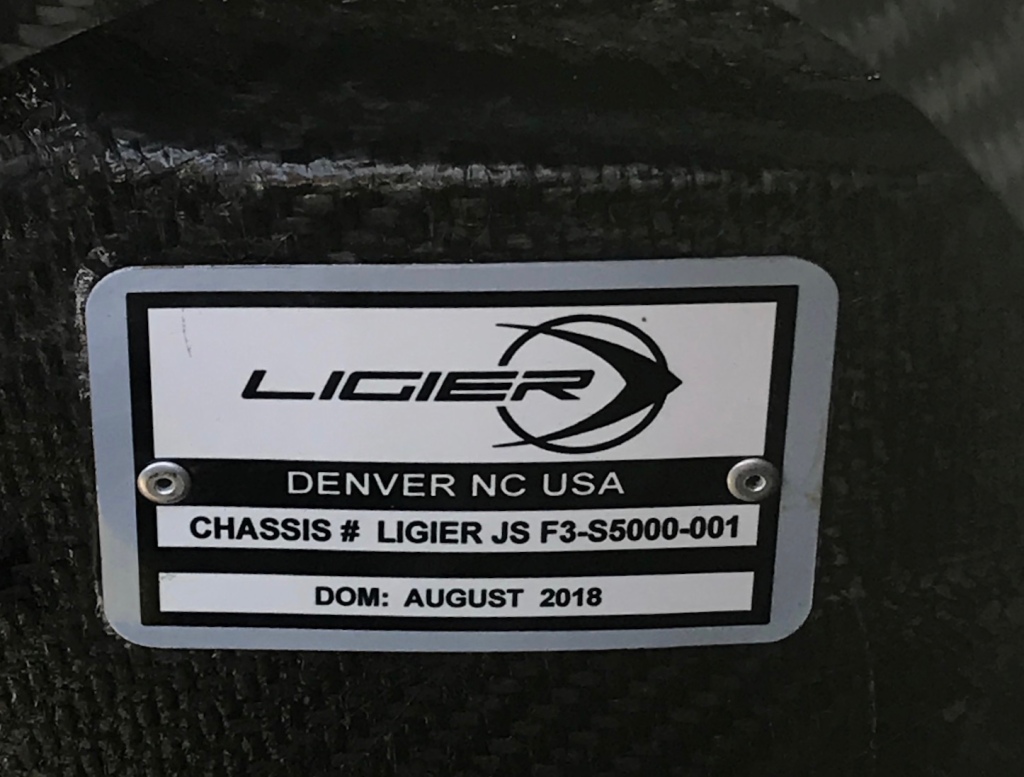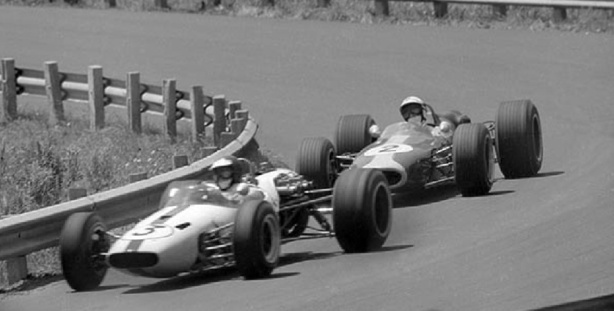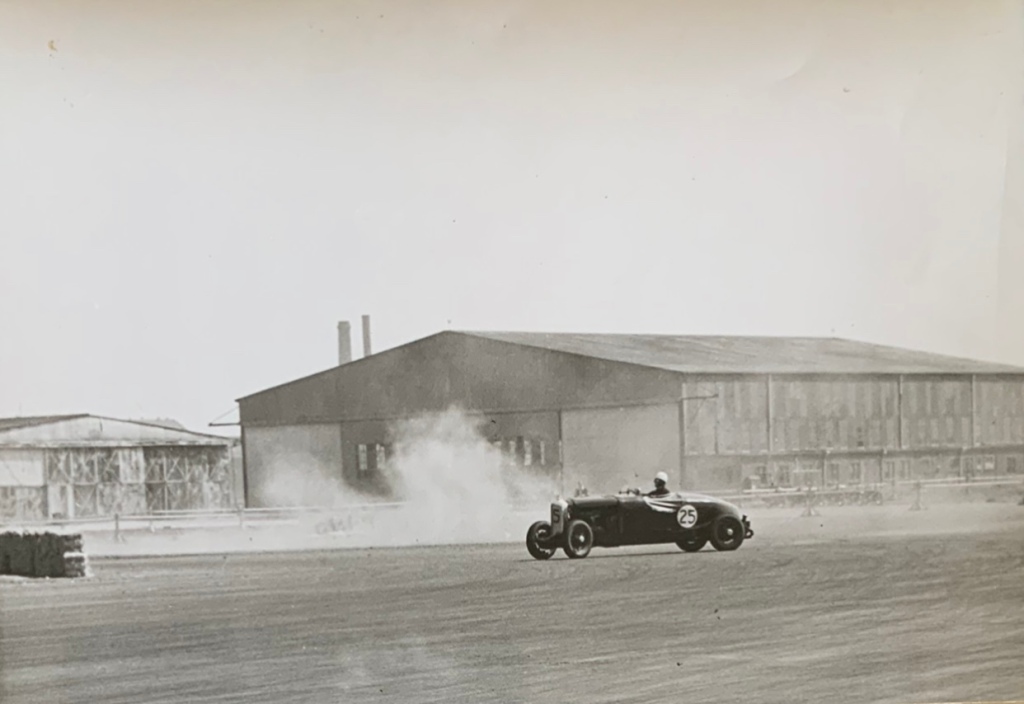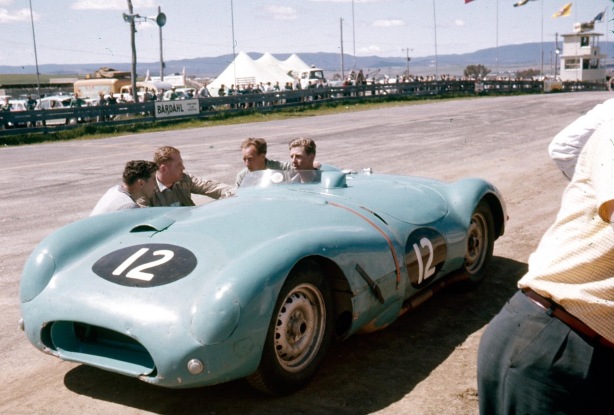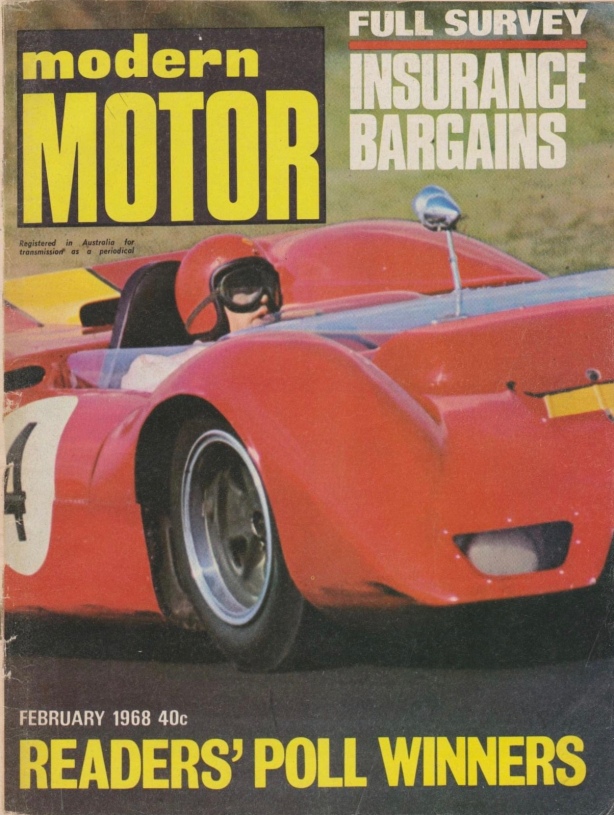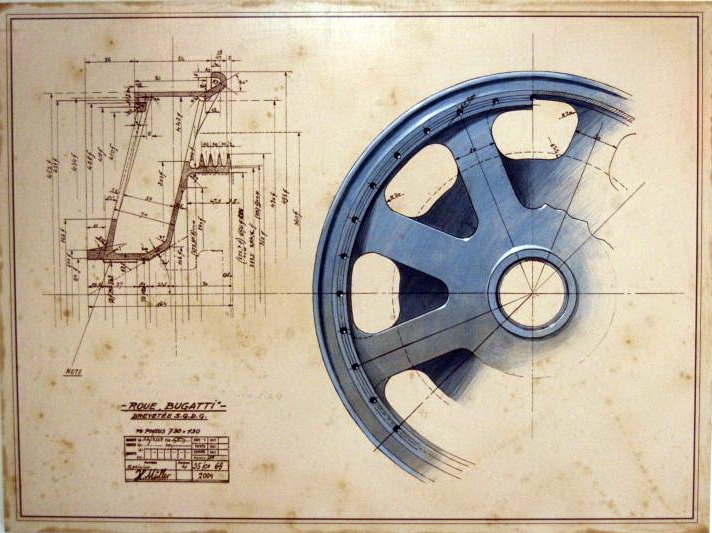
Today we are so used to cast or forged alloy wheels on our cars that we don’t think about them, at least not until we hear that infuriating crunch when we brush a curb. Just when the modern alloy wheel first appeared is subject to some speculation. (See The Nostalgia Forum – https://forums.autosport.com, 12 November, 2009 et seq.) When discussing these wheels, aluminium, magnesium and Elektron (a magnesium alloy) are often confused. Regardless of what we call them, ‘Mag, Alloy or Ali’, there is no disputing that Ettore Bugatti pioneered the use of aluminium wheels on racing cars when he used them on his ground-breaking Type 35 that first appeared at the Grand Prix de l’ACF (French Grand Prix) at Lyon on 3 August, 1924.
Ignoring Bugattis pioneering wheel for the moment, it would seem that cast or forged alloy wheels started to appear in general use in the late 1930’s – perhaps initially in the aviation industry – by this time the USA was a hotbed of experimentation in aluminium casting and alloy development. In England Alex Issoginis used 6 spoke Elektron wheels on his fabulous ‘Lightweight Special’ which he developed in the latter half of the 1930’s. These wheels had integral brake drums, à la Bugatti, but the spokes were bolted to the rim as distinct from being cast in one piece; a technique also used with aircraft.


In the early post-war years, the use alloy of wheels became commonplace, particularly with racing cars. Perhaps the first to use these wheels in this period was John Cooper on his Mark II. Doug Nye in his seminal COOPER CARS , states that Cooper discussed the increasing difficulty in obtaining suitable wheels with his cousin Colin Darby and they came up with the idea of casting wheels with an integral brake drum “like Bugatti pre-war”.
They patented their design and had them cast, claiming that the wheels were “lighter and stronger than the old Fiat type”. Arthur Owens, THE RACING COOPERS, states that their first production alloy wheels appeared in 1947 and were “cast in Elektron with 8-inch brake drums cast integrally”. Others state that it was in 1948 that the Cooper Mk. II, their first production model, appeared with these wheels. Again, claims were made for better brake cooling, more rigidity and better access to the brakes. Other small-time manufacturers such as Laurie Bond with his eponymous Bond ‘C’ type of 1948 used alloy wheels; in the case of Bond, they were to his own design.
Meanwhile across the pond, ex-Douglas aircraft engineer Ted Halibrand began experimenting with magnesium alloy wheels in 1946 which he first used on his own midget racing car. He tried them out on Indy cars in 1949, but had problems with cracking and the soon to become ubiquitous Halibrand cast wheel did not appear at the Indianapolis 500 until 1950. Subsequently, every Indy car between 1951 and 1967 wore Halibrand wheels and Halibrand’s influence still looms large in the wheel industry and hot rod community.

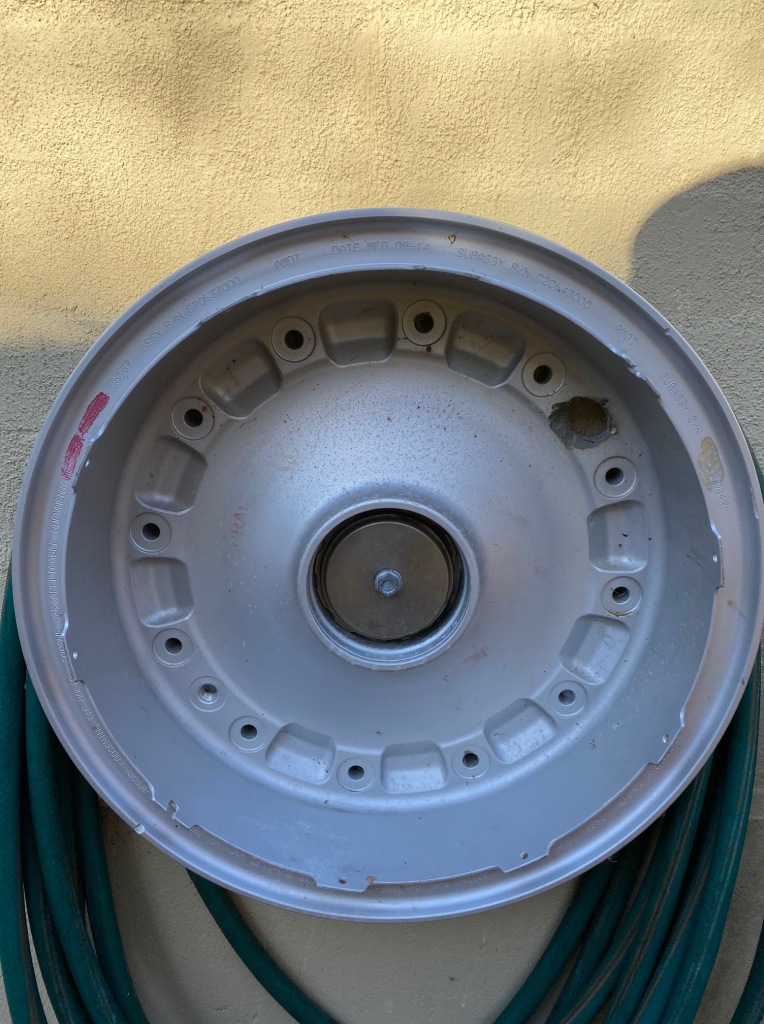
Historically, it had been generally accepted that the cast aluminium wheel was solely the product of the inventive mind of Ettore Bugatti. However, in 1981 influential American automotive historian Griffith Borgeson (1918-1997) set the cat among the pigeons with his BUGATTI by BORGESON (Osprey). The sub-title of this book is ‘The dynamics of mythology’, and in it he tries, at times too hard, to discredit some of the pioneering work of Bugatti. In chapter 13, ‘Wheels within Wheels’, Borgeson claims priority for the invention of the aluminium wheel for Harry A Miller in a US Design patent of 4 May 1920,

Recently, while researching the racing history of Diatto factory works driver Carlo Massola we were shown a book on the marque by Sergio Massaro titled simply: DIATTO. We were astonished to see that on the front cover there was depicted a car with what appeared to be cast wheels. In fact, in 1923 ‘Automobili Diatto’ produced a version of their racing Tipo 20S with aluminium wheels described by Massaro as “the fantastic ‘holey’ wheel” which was cast in light alloy.
It is important to understand that there had been a long-standing relationship between Bugatti and Diatto dating back to their membership of the Turin branch of Club Automobilisti d’Italia as early as 1899 or 1900. According to Steinhauser’s ETTORE BUGATTI, Pietro Diatto, who was nine years older than Ettore, ‘Took an interest in Bugatti’s prototype T8 in 1907. Their relationship was uninterrupted’.
The T8 refers to Bugattis eighth car design which was for the German industrial giant that was Deutz. It was in effect a prototype for future Bugattis with an overhead cam actuating vertical valves via ‘banana’ tappets – a design feature later glorified by his highly successful Brescia model. In October 1915 Louis Panabel, the Diatto agent for France, obtained an option for Bugatti’s pioneering eight in-line steel-block aero engine in the name of Cavaliere Pietro Diatto. This was the aero-engine which had grown from Ettore’s concept for a luxury car engine of eight cylinders with which he had been experimenting since 1912.
The Diatto-Bugatti aero engine was successfully tested in September 1916, Diatto sending an enthusiastic telegram to Bugatti “I am happy to announce the excellent results for the engine … the testing resulted in a brilliant 210 HP”. This collaboration led to a 1919 agreement in which Bugatti was to supply Diatto with fifty 16 valve car chassis made in Molsheim; they were to be fitted with Diatto radiators. (Other than the radiator and the bonnet, these cars were identical to the Bugatti factory product – they are what today is referred to as the ‘Brescia Bugatti’).
Three of these Diatto-Bugattis were shown at the Paris Motor Show in 1919, all with a Diatto radiator with a Bugatti badge. Bugatti displayed two of his outdated 8-valve cars on another stand. Bugatti was a late entrant for the show, and it would appear that the industrial giant Diatto had stolen a march on the under-funded Molsheim factory. There is an unsubstantiated claim in Wikipedia that Diatto also manufactured chassis for Bugatti.

Dane Claude Teisen-Simony has written of the relationship between Bugatti and Diatto. According to Claude, Diatto, which was the second largest Italian automobile manufacturer post-WWI, formed what was “an absolute dream team. Not only did he start with the collaboration of Bugatti, he also linked-up with the outstanding engineering capacity of Giuseppe Coda of FIAT and SCAT racing fame plus two of the Maserati brothers, Alfieri and Ernesto”.
Teisen-Simony claims that “Bugatti used the much larger Diatto factory and its capacities as a test facility for his new ideas, such as a hollow front axle in 1920 and racing cars with superchargers in 1921”. He states that the remarkable Bugatti hollow front axle was developed as a collaboration between Bugatti and Coda. He notes that Borgeson also referred to a partnership between Bugatti and Coda in the development of the Deutz Type 8.
Although the source of the information on the alliance between Bugatti and Coda is not given, there is sufficient grounds to accept that Diatto and Bugatti worked closely on a number of projects, including aero engines and the sixteen-valve car. Other tangible evidence of the close association between Bugatti and Diatto is indicated by the similarity between their radiator badges and by their adoption of the term ‘Thoroughbred’ translated as, ‘Pur Sang’ and ‘Puri Sangue’ respectively, to describe their cars. It is not clear to the writer when Ettore first used the ‘Pur Sang’ description; but it has been applied retrospectively to the first Bugatti, his Type 13 of 1909 – ‘Le Petit Pur Sang’. Diatto used ‘Puri Sangue’ to promote the company’s success with their Tipo 30 (Bugatti).


The Bugatti cast aluminium wheel.
Cast wheels were not a novelty in 1924, and therefore not patentable; nor would the change from iron to aluminium have had patentable merit. Bugattis first patent for his wheel (FR581308), filed on 5 May 1924, was titled Roue à disque à refroidissement ‘cooled disc wheel’, concerning itself with the increased brake cooling provided via skewed spokes. (In production the spokes were parallel).
The Bugatti wheel was distinguished by its integration of the brake drum into the wheel, but this arrangement was not unique as many automotive wire wheels prior to WWI had their spokes laced into the periphery of the brake drum. Malicet et Blin (MaB) were well known for their use of this design and as parts suppliers to the automotive industry this pattern of combined wheel and brake drum appeared on many, mostly French, cars in the early days. Closer to home, Bugatti used this pattern of wheel on his Type 16, the Bébé Peugeot, from 1912 – possibly this influenced his thinking when it came to making an aluminium wheel with an integral brake drum.



Wheel manufacture had played an important part in Diatto’s history; Guglielmo Diatto was a thirty-year-old wheelwright and coachbuilder when he established his eponymous company on the banks of the Po River in Turin in 1835. In 1838 he patented ‘a perfect wheel’. From what can be seen in a photograph of the wheel taken from the patent application, it appears to be a normal metal spoked cart wheel. Was it the use of metal spokes that made it patentable, or was it a pioneering cast wheel?

Aluminium wheels, Bugatti, Miller or Diatto?
It seems unlikely that Bugatti was influenced by the 1919 Miller design for an aluminium wheel. Miller, strictly, did not patent the design – it was a Model Registration that concerned ‘the ornamental design of a wheel’. The wheel was intended to be used on an innovative racing car known as the T.N.T., but in its one or two track appearances it was fitted with conventional wire wheels. (Mark Dees, THE MILLER DYNASTY) The model registration did not address any perceived mechanical advantage from a cast wheel. The wheel was six spoked, compared with Ettore’s eight spokes, and there is nothing in the model registration to suggest it used an integral brake drum. It appears that Borgeson, not for the first time, was ‘drawing a long bow’ when he suggested that Miller’s design was the inspiration for Bugatti’s cast aluminium wheel.
In regard to the association between Bugatti and Coda, we are prepared to believe that the Diatto and Bugatti aluminium wheels might have had common antecedents. In the absence of documentation, just who influenced who remains unclear. The presence of Giuseppe Coda in the allegedly contemporary drawing of a Diatto 20S with perforated aluminium wheels does imply his possible involvement in this novelty.
Bugattis original patent described the wheel “as consisting of one, two or several discs, pierced in a manner to give the desired form to the ‘arms’ or spokes”. This description better fits the Diatto wheel than the aluminium wheel as it first appeared on the Type 35 Bugatti at Lyon in 1924. Could this design have arisen from discussion between Coda and Bugatti, or was Bugatti inspired to make his own version having seen the cast wheel designed by Coda? Italian patents relating to the aluminium wheel might be revealing.

What is certain is that Ettore Bugatti was the first to produce a practical light alloy wheel for racing and passenger cars – wheels that are now standard on modern cars.
Etcetera…

More on the Aerolite wheels from Stuart Ulph, owner of the Almack Austin.
“I was completely unaware that a commercial fleet had been equipped with Airlite wheels. My knowledge of these wheels (apart from owning some) was derived from the “Motor Sport” article, so to me they were ‘Aerolite’. They were made by Bramber with, I am pretty sure, Dunlop rims, the rims being steel of course. I had wondered if High Duty Alloys were involved in the supply of materials – just speculation.
Pete Almack refers to them as ‘my patented wheels’. I assumed he was the patent holder – he held other patents – but a patent search has revealed nothing. Peter also acted in some sort of consulting capacity to the patents board. It has occurred to me that Bramber may have held the patent.
As far as Austin Sevens are concerned, I know that both 15″ and 16″ wheels were made. I had heard that a ‘Motor Show’ Vauxhall 14 was equipped with Pete’s wheels and I have a set of 16″ wheels which were fitted to a BMW 315. Unlike the Austin 7 wheels, these do not have integral brake drums. The BMW wheels have a patent pending number on them as I recall but even this proved of no use to the searcher.
You would think that more of these wheels might turn up, given that Bramber seem to have sold quite a few sets. I telephoned Bramber circa 1980, by which time they had moved to Wales and their major occupation was in producing trailers for Land Rovers. Though interested by the story, by then they had no records or knowledge of the alloy wheels.”

And this contribution from Dick Ploeg, “You may also wish to add that the Czechoslovakian firm of CZ (CESKOSLOVENSKA ZBROJOVKA), on their 1931 Z13 racing car they copied the Bugatti alloy wheels, with integral brake drums.
Furthermore there was a French make of aftermarket light alloy wheels available shortly before and after WW2. These were seen, I believe, on Amilcars and Peugeot Darlemats of the period. I have no name available at the moment, but it must be recorded somewhere.”
Credits…
Bob King and his collection, Tony Johns, Mike Costigan, Stuart Ulph, Dick Ploeg, Diatto’ Sergio Massaro, Brockbank and other references quoted in the text
Tailpiece…

Finito…








